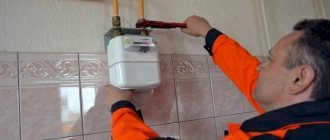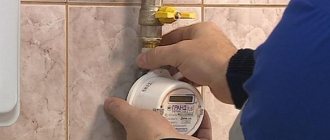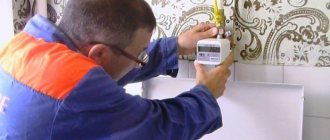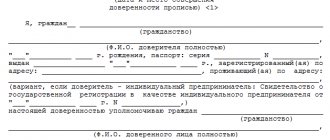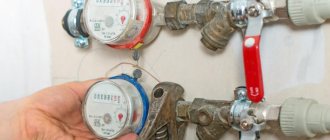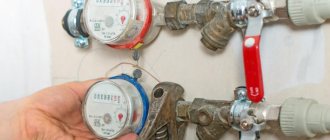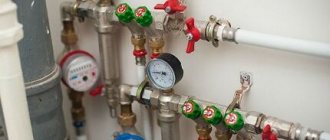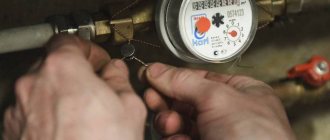Few people will find it difficult to purchase a metering device. The main thing is that it meets state standards and has the appropriate documentation, but not everyone knows how to seal a gas meter.
Meanwhile, the absence of a seal or its incorrect installation is a guarantee of payment for gas according to standards, and not based on consumption. The procedure will take a little of your time, but you must admit, it’s better to take the trouble and do everything right away according to the rules than to pay many times more later and have to redo everything anyway.
We will tell you how to seal the meter correctly, where to go for this, what legal standards to follow, and whether it is worth damaging the “seal” for the sake of dubious savings on twisting readings.
Why seal the meter?
To prevent the consumer from interfering with the operation of the IPU by stopping or slowing down the meter for unaccounted energy consumption, the device is subject to mandatory sealing.
The access indicator is not so easy to bypass and is still the most reliable protection against unauthorized user influence.
Despite the filling, people manage to slow down instrument readings using various means. However, the law does not prohibit resource suppliers from developing and installing seals that prevent various methods of theft
Installation of an indicator or re-sealing occurs in the following cases:
- during the initial commissioning of the IPU;
- failure of the old indicator, its intentional damage, failure of the magnetic indicator, accident;
- replacing the old meter;
- dismantling of the seal for some reason by an employee of the resource supply organization.
In any case, this procedure is necessary and mandatory for everyone who does not want to pay according to the standards.
Legislative acts on installation of seals
The obligation to install meters for energy consumption is determined by Federal Law No. 261 (November 23, 2009, as amended on July 26, 2019) in Article 13, clause 1. At the same time, the requirements of the article do not apply to dilapidated, emergency-type facilities, where gas consumption is less than 2 cubic meters per hour, apartment buildings with wear of 70% and not included in the capital construction program, as well as those subject to demolition and reconstruction.
According to Article 9 of the Federal Law of June 26, 2008 N 102-FZ “On Ensuring the Uniformity of Measurements ,” meters must be equipped with limiters that prevent unnoticed interference in their operation, leading to distortion of readings.
Various types of seals can be installed on the gas meter. On a new one there are at least 2 of them, factory-made and installed during commissioning by gas service employees. Their presence is mandatory
For gas appliances, these are as many as 2 seals, which is indicated in PP No. 549 - a factory indicator and installed by the supplier at the point where the IPU is connected to the gas pipeline. Only if both are intact and from the day of installation of the second one, the meter readings are taken into account.
Replacement frequency
The owner himself can check the condition of the meter if he notices a malfunction, or the gas service supervisory personnel during scheduled or unscheduled checks. Each device is designed for its own operating period, most often it is close to 20 years of use, but each model has its own technical passport, which contains all the data. The replacement and dismantling of an old or damaged device should only be performed by a qualified gas service worker assigned to your area of residence.
Often, when a meter is purchased from private companies, they offer their services for installation and maintenance of the device, but it is prohibited to carry out any work personally.
How and where to apply?
An organization with appropriate accreditation has the right to install a gas meter. However, only the resource supplier can put seals, and therefore put the device into operation.
This can be done on different days, but it should be taken into account that only after the conclusion of an agreement on resource accounting will the countdown of the IPU readings begin.
You can submit an application for sealing during a personal visit to the resource supply organization, but if you do not want/cannot come to the company’s office, you can simply call there. The specialist who responded to your request must leave your address, contact phone number, specify the date of installation of the metering device, and also agree on the date/time of connection at the site.
In addition, you can be called within 3 days on the phone number you left to agree on a different date if work organizations are busy or have an urgent call to another site. However, the new date must be no later than 15 days after receipt of the application.
Please note that the meter must be put into operation and, accordingly, sealed no later than a month after its installation
If the specialist does not appear at the agreed time, or new deadlines are proposed more than 15 days after the application, the metering device can be considered put into operation from the moment a written application for sealing is submitted, in accordance with Government Decree No. 354 .
That is why personal attendance at the office is most preferable. You will have in your hands a document confirming the application, when the specialists call you, they will issue it at the site (unless otherwise provided by the rules of the organization). However, the application procedure is possible only after installation of the device.
Let's consider what documents and subscriber data are needed to seal a gas meter and put it into operation:
- Personal information of the future user - full name, passport data, phone number. If the applicant is a legal entity, then you will also need to indicate the name of the organization and its place of registration, as well as the company’s telephone number.
- Proposed and agreed date for commissioning of the device.
- The type of IPU, as well as its serial number and the place in which it is installed (or it is intended to be installed while simultaneously being sealed).
- If the meter is installed, then information about the organization that carried out the installation.
- Readings on the meter when installing it.
- Verification date according to the intercheck interval from the last factory mark.
You must have a photocopy of the IPU passport with you and, if the device is not new, the latest verification report.
Service cost
The law says that sealing of a gas meter is carried out at the expense of the end consumer. Some companies offer a free service for the initial filling. This applies to the installation of a new gas meter; the procedure for providing the service may have some differences in different organizations.
Each device has a certain period after which the next verification must be performed. Modern gas meters are of high quality, so the frequency can be 10-12 years. Installing a seal on an old device is done at the consumer’s expense. Some companies try to take care of the client’s convenience; sealing is performed at no additional charge, even if re-installation of seals is necessary.
A new seal is required if the gas meter has been damaged as a result of certain user actions. A common cause is the use of a magnet. Magnetic force is often used to change the readings of a gas meter, water meter, electric meter and other metering devices. In this case, the free service definitely becomes paid, and significant fines are collected from clients through the court.
Magnets should not be used for many reasons:
- low impact efficiency;
- risk of breakdown of the gas meter;
- a gross violation of the law leading to serious consequences.
The procedure for sealing the meter
So, a specialist from a gas supply organization has come to you to carry out the procedure for putting the meter into operation.
Even if a gas service employee showed up exactly at the agreed time, before letting him into your home, be sure to check his ID indicating that he works for the gas service
First of all, he checks the documentation for the metering device, the absence of distortions and correct installation, operability and the possibility of a low-burning functionality mode. If something is wrong, he writes you a refusal indicating the reasons; if everything is fine, he installs seals and numbered control and security stickers, the information from which is entered into the acceptance certificate.
A specialist can also install an anti-magnetic seal; the law does not prohibit such actions. The anti-magnetic tape has a capsule, which, when interacting with a magnet (a popular method of braking a meter), is broken and immediately indicates an attempt at unauthorized influence.
The legality of installing antimagnetic indicators is stated in paragraph 81(11) of Government Resolution No. 354 .
After completing all procedures, an act is drawn up in 2 copies, one remains with the organization, the second with the consumer. The act must be carefully studied before signing. Among other information, it contains information about the location of installation of security seals and the date of the next verification.
At whose expense is the filling installed?
The “stamp” on the IPU is installed in the interests of the supplier, that is, the resource supplying organization. On the other hand, companies are not required to put seals on consumer meters, and their presence is legally required.
Initially, when putting the device into operation, the organization installs them free of charge to its subscribers, but subsequent sealings are paid by the client according to a separately concluded agreement. This point is also noted in Government Decree No. 549, paragraph 22 “b” .
After completing the procedure for installing protective seals, be sure to check their integrity before signing the specialist’s work acceptance certificate
The cost of sealing after repair, reinstallation or replacement of a gas meter is set by the supplier, and there are no uniform prices. It may vary depending on the consumables used, the controller’s transportation costs and other nuances, but usually does not exceed 300-400 rubles.
How to remove or bypass a filling?
There is a lot of bad advice on the Internet from experts in bypassing the IPU “seals”. We do not recommend doing this for several reasons.
This procedure is not as simple as it seems at first glance; it is very easy to damage the filling. And even if you succeed, the resource supplying organization can easily pay attention to underestimated consumption figures and carry out an unscheduled inspection. And traces of intrusion into the operation of the meter will be almost 100% visible.
According to the aforementioned RF PP No. 549, if the seal is damaged, the subscriber pays compensation, the amount of which varies depending on how it was discovered.
The most severe monetary fine is provided for the activation of anti-magnetic tape. In different situations it ranges from 3 thousand rubles to 30 thousand
Thus, paragraph 25 states that if the consumer notified the supplier about this on the day the defect was discovered, payment will be made according to general standards from the day the damage was reported until the day following the installation of a new seal.
If the damage was discovered by gas company employees during a standard inspection, compensation will be calculated according to the same standards, but from the date of the last inspection until a new seal is installed. Since inspections are carried out every six months, in accordance with PP No. 549, it is more profitable to immediately contact the service organization and inform them that you have problems with the integrity of the indicator.
In addition, you may be fined for damaging the “seal”, according to the Code of Administrative Offenses of the Russian Federation, Article 19.2 . The amount, however, is small - from 100 to 300 rubles. But if deliberate destruction of the indicator is proven, the fine can be much higher.
Sealing a gas meter: price, terms and other details
Quite a lot of questions arise specifically with the sealing of a gas account, and not with its purchase (we have prepared for you a detailed guide to choosing a meter for an apartment).
In this article, we will look at why sealing is needed, what types of seals exist, how much this procedure costs, in what time frame it should be carried out, and why there is no need to use various “twists” of indications.
Let's start with the important thing: sealing the gas meter is mandatory . Its presence and integrity confirms that the user does not interfere with the operation of the device and its readings are reliable.
Therefore, the gas distribution company takes into account only the readings of the sealed device.
If you do not want to pay for gas according to the standards, you need to contact your gas supplier as soon as possible, preferably immediately after installing the gas meter.
According to Decree No. 549, there are two seals on each gas meter. One is installed immediately at the manufacturer’s factory, which confirms that the device is working properly and there has been no interference with its operation. Information about the seal is contained in the technical data sheet of the equipment.
The second seal is already installed by the gas supplier and only if there is a factory seal. It is installed after installation, at the point of connection to the gas pipeline.
Seals also differ in the principle of protection:
- Stickers . The simplest option. Temporary protection if it is not yet possible to use another type of filling.
- Lead . They are usually used as a factory seal and do not allow the device case to be opened. Made in the form of a nail, the impression contains all the necessary information about the filling.
- Plastic clamp . It is impossible to remove such a filling without cutting, and any interference will be obvious. The most inexpensive and practical type of filling.
- Antimagnetic . This seal is the most modern and reliable. It is a small sticker with all the necessary data. Usually it is installed directly on the meter body. If you try to tear off such a sticker, a special color or inscription will appear. In addition, if you try to “deceive” the counter using a magnet, the indicator will immediately change color.
The type of sealing is chosen by the gas distribution company at its discretion. But you can ask for a certain type of seal to be installed; usually gas workers will accommodate you if there is such a possibility.
The sooner you apply for sealing of the meter, the sooner you will start saving without paying for gas according to the standards.
The gas meter is sealed only by employees of the gas supplier. According to Resolution No. 549, they are obliged to carry it out within 5 working days from the date of submission of the application.
However, if they do not meet this deadline, then a new date must be agreed with you, which cannot exceed 15 working days from the date of receipt of the application.
If sealing was not carried out within these periods, then the meter is considered sealed and put into operation from the date of submission of the application. This is clearly stated in Resolution No. 354.
To apply for sealing you will need the following package of documents:
- passport of a citizen of the Russian Federation;
- the meter installation certificate and documents provided by the gas service that carried out its installation;
- technical passport of the equipment.
Self-sealing is prohibited. Such actions may result in administrative and criminal liability.
An employee of the gas distribution company conducts a visual inspection of the gas meter: checks the presence and integrity of the manufacturer's seal, the absence of mechanical damage on the meter body, and also checks compliance with the manufacturer's requirements during installation.
If any inconsistencies are found or the device is damaged, then the gas technician has the right to refuse sealing. It can be carried out only if all violations are eliminated.
However, if everything is in order with the documents and seals, the meter will be sealed, you will be given a sealing certificate and from that day the meter readings will begin to be taken into account.
The initial sealing of gas equipment (immediately after installing the gas meter) is carried out by the gas service free of charge . Repeated (after verification of the meter, its replacement or reinstallation) is paid at the expense of the owner. There are no uniform prices, usually it is about 300-400 rubles . This includes the cost of the filling, transportation costs and the work of a specialist.
If you find that the seal has been damaged, then follow the following algorithm.
- Step 1. Immediately notify your gas supplier by calling customer service.
- Step 2. They will send a controller who will detect the malfunction and schedule an unscheduled inspection of the equipment.
- Step 3. If the seal was broken accidentally, and the meter itself is working properly and there are no complaints, then it will simply be resealed.
You will incur costs for re-sealing, a fine will be issued for damage to the seal, and you will also pay for gas according to the standards while the device was not sealed.
If you break the seal by accident, a fine of 100 to 300 rubles will be imposed, according to Article 19.2 of the Code of Administrative Offenses of the Russian Federation.
But this only applies to seal stickers. Other types of seals cannot be “accidentally” damaged, especially anti-magnetic ones. All damage is usually associated with bypassing the protection, attempts to “twist” the meter readings. It is useless to look for options for self-sealing. Any interference will be obvious and detected during a routine inspection.
In this case, the gas service will order an examination of the seal and send all materials to the court. The gas service has the right to recover from the violator all expenses incurred, which may exceed 3,000 rubles .
As you can see, sealing gas meters, although it takes time, is not that difficult. We have covered all the important details in this article. If you still have any questions, write to x, our specialists will answer each of them.
What to do with the seal when replacing the meter?
If you are going to change the meter or when sending it to the laboratory for verification, do not rush to dismantle the device, even if all deadlines have already expired.
Before signing the desealing act, be sure to check the correctness of the specified data, that is, the condition of the seal, its integrity and the latest gas meter readings
Replacement if its functionality is impaired or simply choosing another model is carried out by specialists from the organization with which the subscriber has an agreement. In this case, it is necessary to take the latest readings and check the integrity of all seals. For this procedure, you will also need to draw up an application and sign an inspection report.
The re-sealing procedure is carried out similarly to the primary one. In this case, do not forget to take a receipt for payment for the sealing.
Conclusions and useful video on the topic
Here's why you shouldn't try to fool metering devices:
The procedure for sealing a heat meter is very important for every consumer. It is one of the main parts of putting the device into operation and the starting point when paying for resources according to its indicators. As you can see, it is not at all difficult as it seems and not so expensive.
Share in the comments with our readers how your gas meter was sealed and what difficulties you encountered. And also, ask questions - we will try to answer even the most complex of them in detail.
Price for sealing water meters
The City Center for Accounting and Saving of Resources in Moscow is engaged in the full cycle of work on IPU water. You can definitely call at any time and place an order for installation of water meters, verification or sealing. By the way, sealing is done free of charge. There is no price for it.
Sealing itself is part of the process of installing or replacing mechanisms. Sealing is one of the most important functions when servicing instrument equipment.
Do you have questions about sealing meters? Write! We'll call you back

